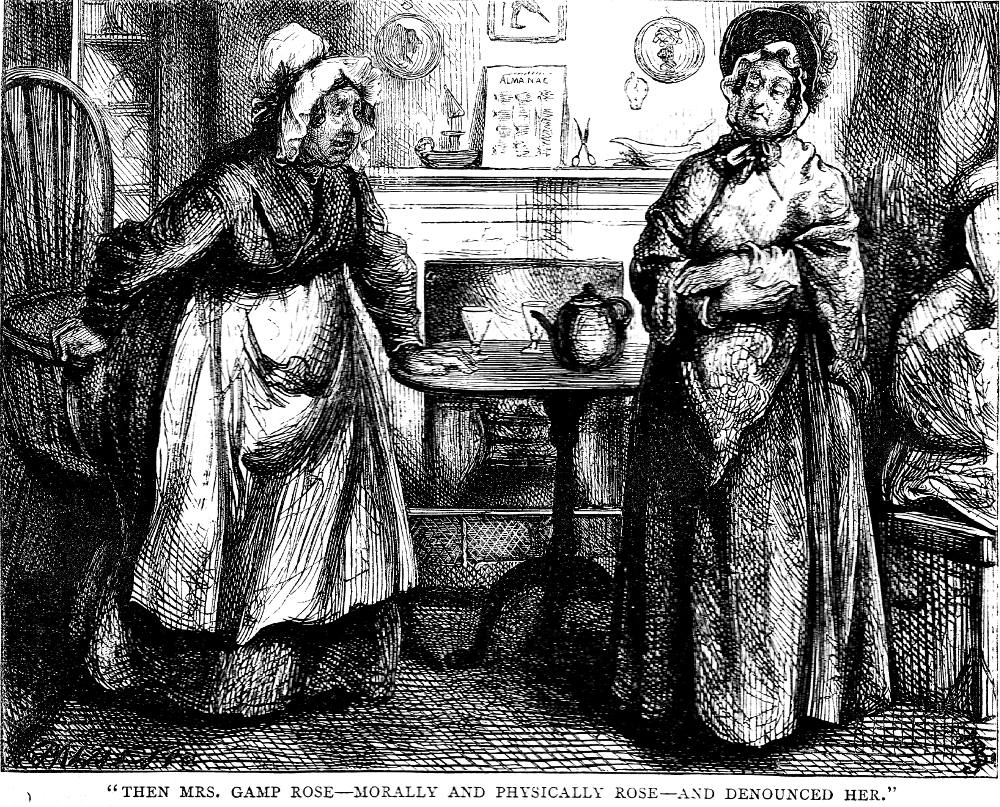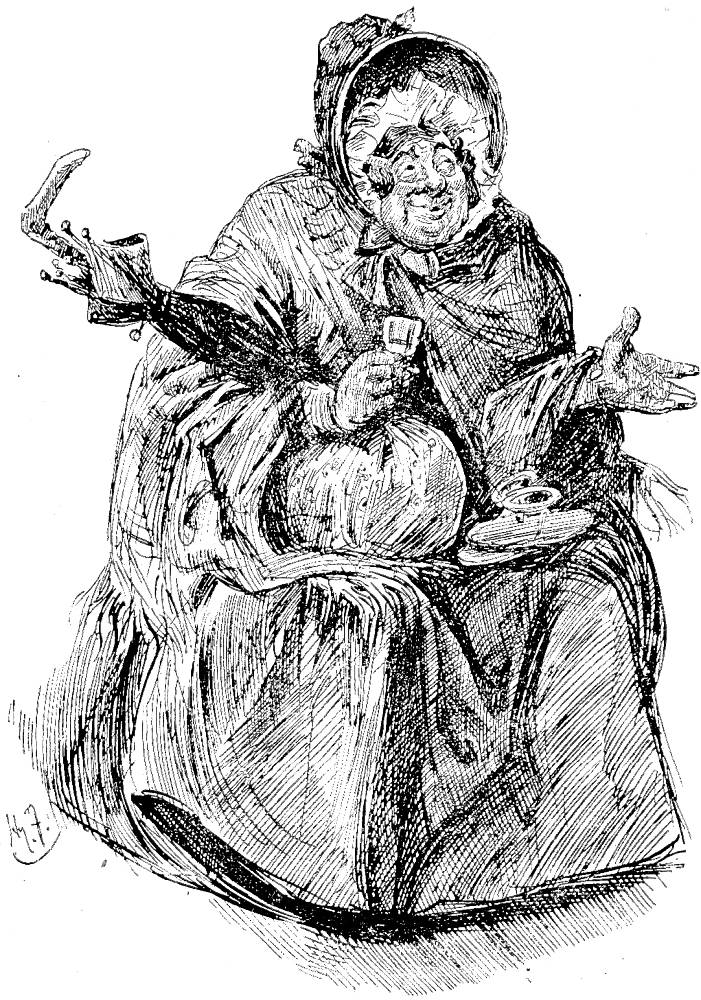Sairey Gamp and Betsey Prig
Harold Copping
1924
Colour lithography; originally "oilette."
Approximately 7 x 5 inches (17.8 x 12.4 cm), framed.
From Character Sketches from Dickens, facing p. 76.
Scanned image, caption, and commentary below by Philip V. Allingham
[You may use this image without prior permission for any scholarly or educational purpose as long as you (1) credit the person who scanned the image and (2) link your document to this URL in a web document or cite the Victorian Web in a print one.]
Commentary: Copping's Debt to the Phiz Original
It is instructive to compare the original etching on steel by Hablot Knight Browne ("Phiz") with Copping's 1924 lithograph. According to critic Michael Steig, in the original serial of 1843-1844 "Plate 35 (No. XVIII), Mrs. Gamp Propoges a Toast, is the third and last [illustration in Phiz's narrative-pictorial program for the serial version of the novel] to feature Sairey Gamp in person. This famous illustration, depicting the moment immediately preceding the apostasy of Betsey Prig [the moment which Fred Barnard in the Household Edition chose instead], is by and large a faithful reproduction of Dickens' description of the scene, down to the bursting bandboxes, the pattens, the pictures over the mantel, the umbrella, and the garments looking like a hanged double of Sairey" (DSA 2, 139).


Left: Phiz's June 1844 serial engraving Mrs. Gamp Propoges a Toast (Chapter XLIX). Right: In the Household Edition, Vol. II, Fred Barnard's Then Mrs. Gamp rose — morally and physically rose — and denounced her (1872).
The scene which Copping has chosen to exemplify the comedic aspect of the picaresque novel Martin Chuzzlewit, Sairey Gamp and Betsey Prig, occurs in what was originally episode eighteen (Chapter 49, "In Which Mrs. Harris, Assisted by a Teapot, is the Cause of a Division Between Friends," June 1844). Compare Copping's more realistic handling of his materials to Phiz's Mrs. Gamp Propoges a Toast. Gone are the lovingly realized background details such as Sairey's additional outfits hanging above the friends about to experience a falling-out.
In one of his prefaces to Martin Chuzzlewit, Dickens declares that his main object was "to exhibit in a variety of aspects the commonest of all vices; to show how selfishness propagates itself; and to what a grim giant it may grow, from small beginnings." In the person of Pecksniff he created a character that has become a by-word for hypocrisy, whilst other characters, such as Sairey Gamp and old Martin Chuzzlewit, have taken their place in the gallery of immortals. On the reverse side, equally inimitable, are to be found Tom Pinch, Mark Tapley, Ruth Pinch, John Westlock, and scores of others. The selections made from the book represent these phases. Old Martin is introduced in the first excerpt, delightful Ruth Pinch and her brother in the next, whilst the immortal tea party of Sairey Gamp and Betsy Prig forms the third. [Matz 68]
Margaret Cardwell suggests in her introduction to the World's Classics edition of the novel (1984), that "The reader wants Mrs. Gamp and Mr. Pecksniff to survive for ever, perpetually exhibiting the resilience which is theirs" (xiii), and this illustration fulfills the reader's desire for a quintessential image of the indefatigable sick-room nurse, one that Copping has directly based on Phiz's original serial illustration Mrs. Gamp Propoges a Toast. Copping would have been well aware that this captioned illustration for Chapter XLIX, "In Which Mrs. Harris, Assisted by a Teapot, is the Cause of a Division between Friends," Part 18 (June 1844) marks a turning point in the Sairey-Betsey relationship; as the serial novel drew to its poetically just conclusion, Dickens created a sharp falling out between the nursing confederates.
Although Dickens originally aligned the boozy Sairey with the novel's deceivers and hypocrites, the voluble alcoholic grew beyond that original orientation in the minds and hearts of the Victorian novel-reading public. She became over the course of fifty chapters an endearing, comedic figure. Although the novelist must have felt the necessity to expose Mrs. Harris as a product of Sairey's fecund imagination and verbal creativity, one senses that Dickens could not bring himself to explode Mrs. Harris's inventor. Despite her considerable bulk, alcohol-slurred discourse, and obvious humbug, Sairey Gamp is akin to her thirty-four-year-old story-teller, Dickens, because she, too, has constructed a character for her own satisfaction and self-affirmation. Her fictive friend, Mrs. Harris, exists primarily for the sake of advertisement, at least in Sairey's mind. She provides Sairey with countless testimonials to the calibre of her friend's sick-room ministrations to those leaving this world — as well as to those entering it. Thus, Dickens the story-teller puts his reader in the odd position of ardently hoping to see Mrs. Harris dispatched as a Dickensian Bunbury, on the one hand, but also sentimentally convinced that Sairey should be left, psychologically speaking, intact. The memorable passage alluded to by Copping in 1924 and originally realized by Phiz in 1844 occurs just prior to an explosion of Betsey Prigg's exasperation at yet another of Sairey's allusions to the devoted Mrs. Harris:
"Betsey," said Mrs. Gamp, filling her own glass, and passing the teapot, "I will now propoge a toast. My frequent pardner, Betsey Prig!"
"Which, altering the name to Sairah Gamp; I drink," said Mrs. Prig "with love and tenderness." [Martin Chuzzlewit, Chapter XLIX]
Shortly, their mutual tenderness will suddenly morph into chagrin, rancour, and vituperation as Betsey, imbibing too freely of the gin-charged teapot, pronounces upon Mrs. Harris that fateful sentence of annihilation: "I don't believe there's no sich a person!" This falling out (or, confronting her latent disbelief in Sairey's imaginary friend) is all the more ironic because Betsey, despite her employment in a public health institution (St. Bartholomew's Hospital), is a virtual twin to Sairey, not only in physique (as Phiz's illustration demonstrates), but also in her slatternly conduct, brutal exploitation of patients in her charge, and utter ignorance of the principles of professional practice. Perhaps, therefore, the falling out is prompted by jealousy, simply because Betsey cannot brook the notion of her confidant's having another crony, no matter how elusive.
Copping seems to have studied Phiz's original illustration carefully, for although his perspective has shifted from a frontal ('theatrical') to a side view (in Copping's plate we must be standing to one side of Betsey Prig), the later artist has included the cupboard (immediately behind Sairey, denoted by her large hat), the edge of mantelpiece with the picture of Mrs. Harris, the assorted hat boxes, the mahogany chairs, the handle-less chest of drawers (depicted off-left in Phiz's plate), and the teapot strategically located between the imbibers. Since Copping has, as it were, zoomed in on the pair, he cannot show either the massive bed or the pair of gowns hanging above it. A curious departure is the red fringed tablecloth Copping has added. Although equally corpulent, Copping's nurses have less cartoon-like, more realistic faces, in keeping with his more realistic style of portraiture. Whereas Phiz's figures are almost lost in the detailed realisation of Mrs. Gamp's cluttered room, presented as if it were a stage set, Copping fills his frame with his two subjects, whose glasses are clearly gin-filled and somewhat larger than their counterparts in the original monthly etching.
Much of the charm of Sairey Gamp in the Phiz illustrations is lost in Copping's coloured but relatively colourless character study of an overweight, bleary-eyed, ungracefully aging slattern. Patient, plodding realism is the wrong mode for visualizing the distinctive voice of Dickens's Sairey Gamp. The caricaturist Phiz, in contrast, presents the interior of the first floor front in all its detail as an extension of Sairey herself, jumbled, confused, whimsical, and thoroughly engaging: a Dickensian original, almost superfluous to the novel's plot but one of the best things in The Life and Adventures of Martin Chuzzlewit.
Other Illustrators' Interpretations of the Divine Sairey



Left: Kyd's Tuck card colour lithograph of Sairey Gamp with an oversized "gamp" (umbrella): Sairey Gamp in The Characters of Charles Dickens pourtrayed in a series of original watercolours by "Kyd" (Clayton J. Clarke, 1911). Centre: Harry Furniss's realisation of the scene in which Betsey Prigg reaches the breaking point with Sairey's testimonials by Mrs. Harris, Betsey Prigg and Mrs. Gamp (Charles Dickens Library Edition, Ch. LI, 1910). Right: Clayton J. Clarke's characterisation of Sairey as endearing rather than professionally irresponsible and thoroughly addicted to gin, Sairey Gamp (Player's Cigarette Card No. 24 in Characters from Dickens, 1910). [Click on the images to enlarge them.]



Left: Barnard's later frontispiece of Sairey Gamp: Mrs. Gamp on the Art of Nursing (1879). Centre: Furniss's introductory realisation of the sickroom nurse: Sairey Gamp (Charles Dickens Library Edition, 1910). Right: In the Household Edition, Vol. II, Barnard's "Well, Mrs. Gamp, and how are you, Mrs, Gamp?" said this gentleman, in a voice as soft as his step (1872).
Relevant Illustrated Editions of this Novel (1849 through 1910)
- Dickens's Martin Chuzzlewit (homepage)
- Illustrations by Which to Read Martin Chuzzlewit: The Phiz Steels (1843-44) or the Barnard Woodcuts (1872)
- Phiz's 40 serial illustrations for Martin Chuzzlewit (January 1843 - July 1844)
- Barnard's 60 Household Edition illustrations for Martin Chuzzlewit (1872)
- O. C. Darley's Frontispiece in the New York edition (Vol. 1, 1863)
- O. C. Darley's Frontispiece in the New York edition (Vol. 2, 1863)
- John Gilbert's Frontispiece in the New York edition (Vol. 3, 1863)
- O. C. Darley's Frontispiece in the New York edition (Vol. 4, 1863)
- Sol Eytinge, Junior's fifteen Diamond Edition Illustrations (1867)
- Kyd's five Player's Cigarette Cards, 1910
- Harry Furniss's 29 Illustrations for Dickens's Martin Chuzzlewit in the Charles Dickens Library Edition (1910)
Bibliography
Cardwell, Margaret. "Introduction." Charles Dicklens's The Life and Adventures of Martin Chuzzlewit: His Relatives, Friends, and Enemies; Comprising All His Wills and His Ways: With an Historical Record of What He Did, and What He Didn't: Showing, Moreover, Who Inherited the Family Plate, Who Came in for the Silver Spoons, and Who for the Wooden Ladles. The Whole Forming a Complete Key to the House of Chuzzlewit. Edited by Boz. With Illustrations by "Phiz" (1843-44). Oxford and New York: Oxford U. P., 1984.
Matz, B. W., and Kate Perugini; illustrated by Harold Copping. Character Sketches from Dickens. London: Raphael Tuck, 1924. Copy in the Paterson Library, Lakehead University.
Steig, Michael. Dickens and Phiz. Bloomington and London: Indiana U. P., 1978. [Complete text]
______. "Martin Chuzzlewit's Progress by Dickens and Phiz." Dickens Studies Annual 2 (1972): 119-149.
Victorian
Web
Charles
Dickens
Illus-
tration
Harold
Copping
Next
Created 15 February 2009 Last modified 28 October 2023
